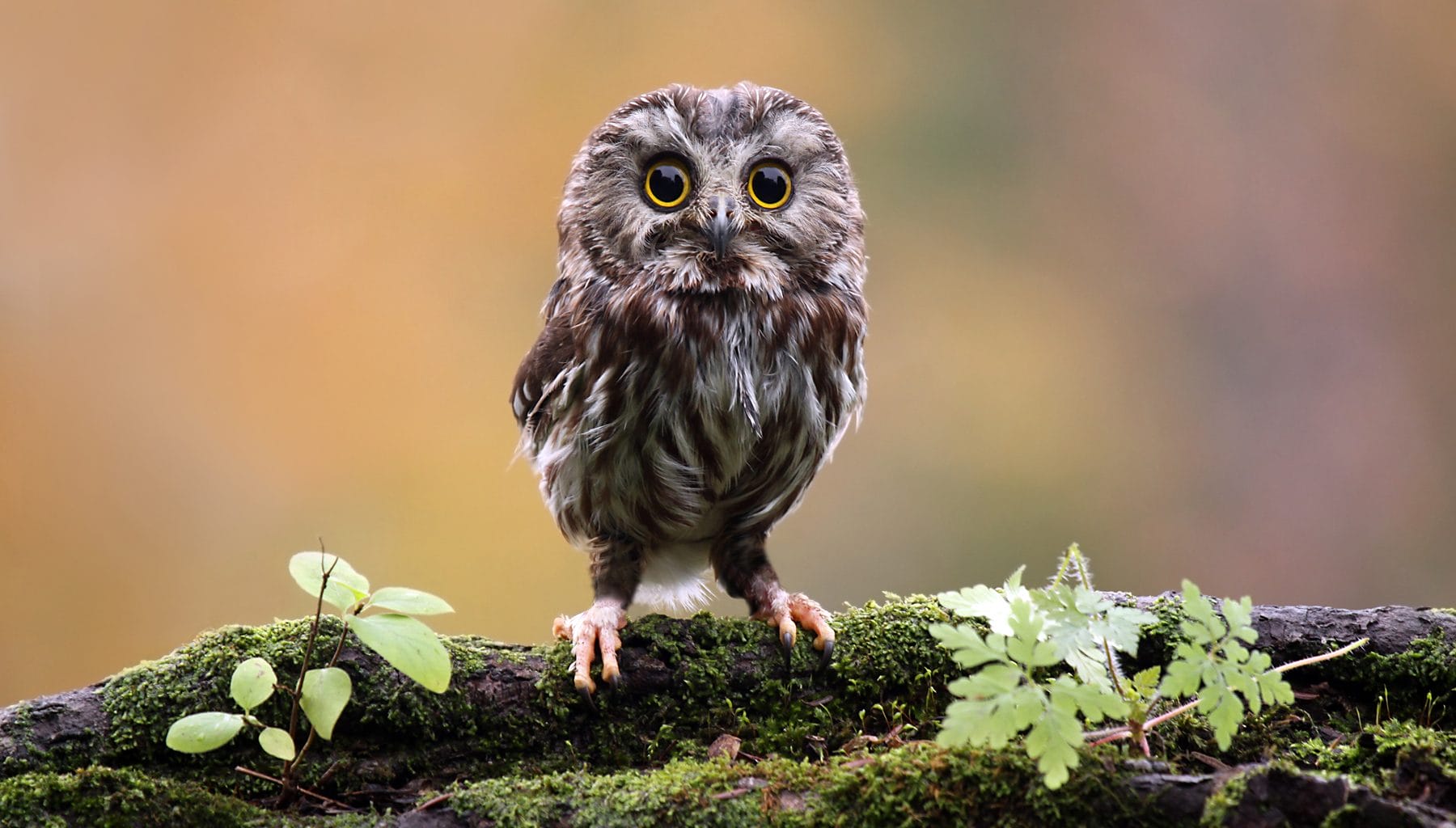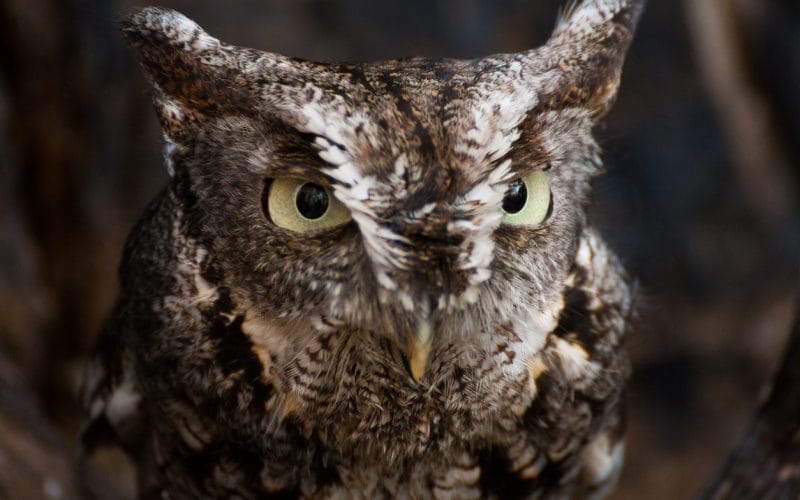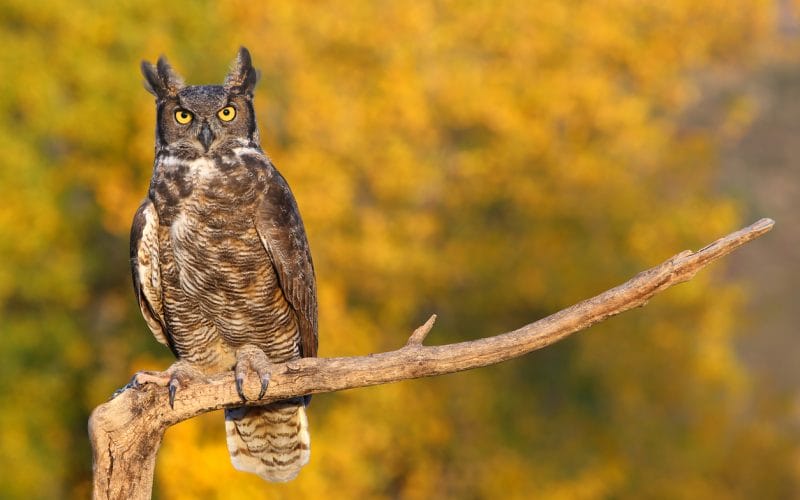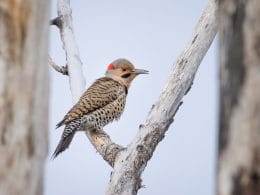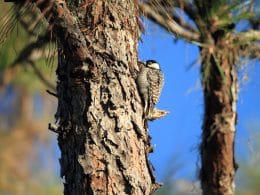The state of Virginia houses eight gorgeous species of owls. Some appear in just about every region of the state—like Great Horned Owls and Barn Owls—while others visit once every blue moon.
Since owls typically reside in heavily wooded areas, most of them are heard rather than seen. But if you’re lucky, you might find an owl on the prowl just before the sun sets, as some are diurnal and thus actively hunt during daylight hours.
In this article, I’ve listed all eight species of owls in Virginia. Read on for detailed information on how to find and identify them!
1. Great Horned Owl
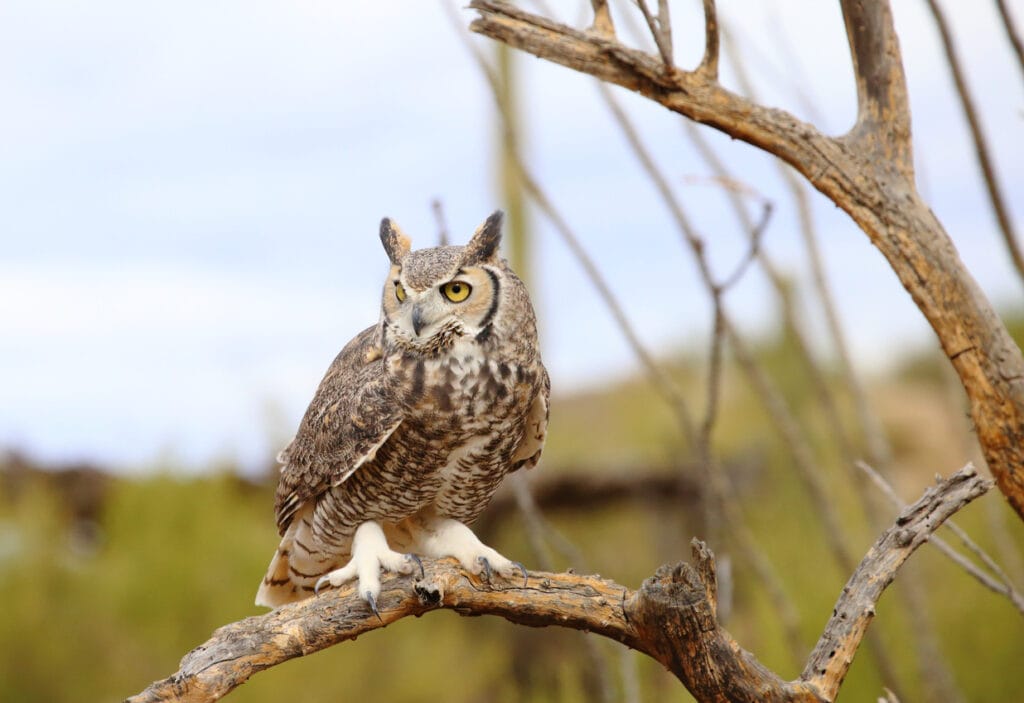
- Scientific name: Bubo virginianus
- Length: 18 to 26 inches
- Wingspan: 55.5 inches
- Weight: 50 ounces
- Lifespan: 10 to 15 years (wild); 28 years (oldest recorded)
Often found in literature, children’s books, and TV, Great Horned Owls are perhaps the most iconic species of owls in the world. They’re found year-round in Virginia, which is great news for owl fanatics.
Be warned, though: Great Horned Owls attack when threatened, so they’re best admired from afar. They’re not actively hostile, but they’re not the friendliest creatures either.
Author Note: Great Horned Owls are the largest owls in Virginia and the third-largest in the world, after Eurasian Owls and Blakiston’s Fish Owls. Adult Great Horned Owls measure up to 26 inches in length, which is about as tall as an adult-sized Bernese Mountain Dog.
As per their namesake, these owls have horn-like tufts pointing up their heads. They have broad, barrel-shaped bodies, mottled dark-brown plumage, mahogany faces, and large, intimidating yellow eyes, making them easily distinguishable from other owls in Virginia.
When it comes to food, Great Horned Owls aren’t picky. Thanks to their immense size, unwavering strength, and aggressive nature, they can handle large prey such as falcons, ospreys, and birds up to the size of geese and ducks.
With that said, the majority of their diet consists of smaller mammals like rats, mice, rabbits, skunks, opossums, and squirrels. They sometimes eat snakes, frogs, insects, and, if push comes to shove, fish (but not if they can help it!).
2. Eastern Screech-Owl
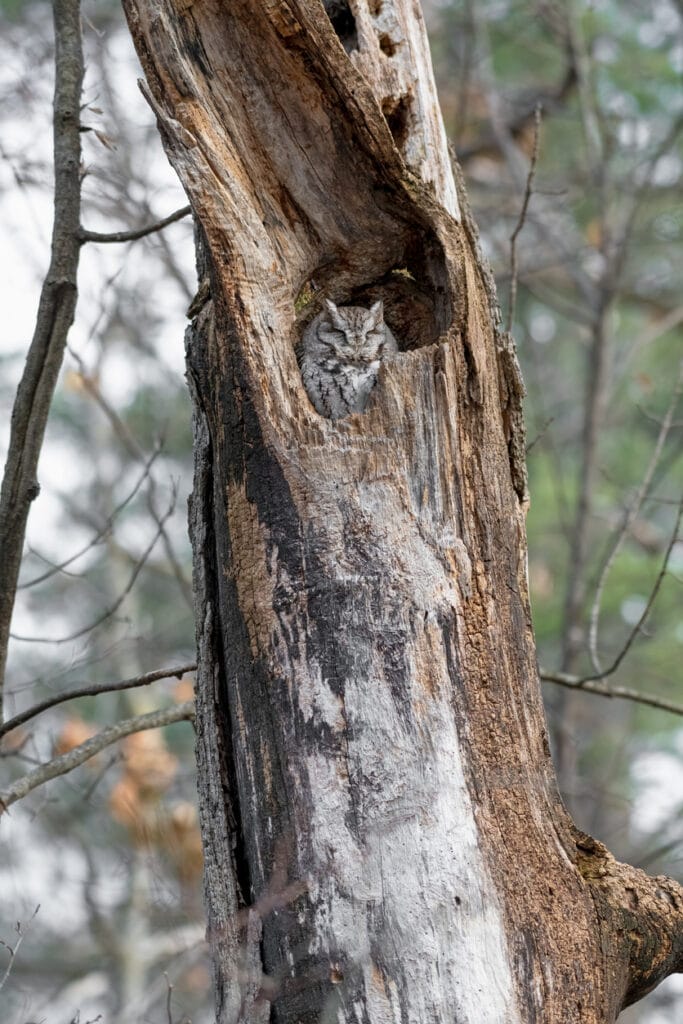
- Scientific name: Megascops asio
- Length: 6 to 10 inches
- Wingspan: 19 to 25 inches
- Weight: 5 to 5.60 ounces
- Lifespan: 8 to 10 years (wild); 14 years (oldest recorded)
Identified through their one-of-a-kind screeching call, Eastern Screech-Owls are among the most common owls in Virginia. From deciduous forests to backyard nest boxes, these year-round residents are found wherever trees are.
Although common, their camouflage patterns make them difficult to spot, especially during nighttime. They usually hide out in nooks and crannies of trees, their gray and red-brown patterned feathers blending them perfectly.
Eastern Screech-Owls are small but stocky. They have pointed ear tufts, square tails, and round wings.
Some people mistake them for Western Screeh-Owls, their slightly larger cousins. Indeed, both look increasingly similar. Western-screech Owls rarely visit Virginia, though, so you’re ten times more likely to encounter an Eastern-screech Owl rather than a Western Screech-Owl in Virginia’s forests.
Eastern Screech-Owls mostly eat small mammals and rodents, such as shrews and deer mice, as well as insects, earthworms, crayfish, frogs, and other invertebrates.
They’d also sometimes nab a fish from other creatures as a quick snack.
3. Snowy Owl

- Scientific name: Bubo scandiacus
- Length: 21 to 25.5 inches
- Wingspan: 48 to 59 inches
- Weight: 40 to 70 ounces
- Lifespan: 10 (wild); 23 years (oldest recorded)
Renowned for their striking white plumage and exotic beauty, Snowy Owls are one of the most unmistakable owls species in the world. They rarely migrate to Virginia, but when they do, it’s a sight to behold.
Author Note: In Virginia, Snowy Owls appear in a phenomenon called irruptions, in which owls “invade” an area in large, unpredictable numbers.
Usually, Snowy Owl irruptions occur every four years or so, typically after a summer of high breeding numbers. The last interruption in Virginia happened in 2015, where dozens of Snowies sat on the roof of an unsuspecting house for hours, unfazed by the local “paparazzi” admiring their beauty.
In terms of size, Snowy Owls give Great Horned Owls a run for their money, with some reaching 28 inches in length.
They’re quite defensive, as well, and will attack anyone who threatens their nest, regardless of how large. In fact, they were seen fearlessly attacking arctic wolves that have come too close to their nesting sites!
Although large, Snowy Owls rarely make noise. They’re virtually silent during non-breeding seasons.
During the breeding season, males give out a booming, “hoo, hoo” to advertise their territorial ownership. Females give out a similar but higher-pitched call, but only when absolutely necessary.
4. Long-eared Owl
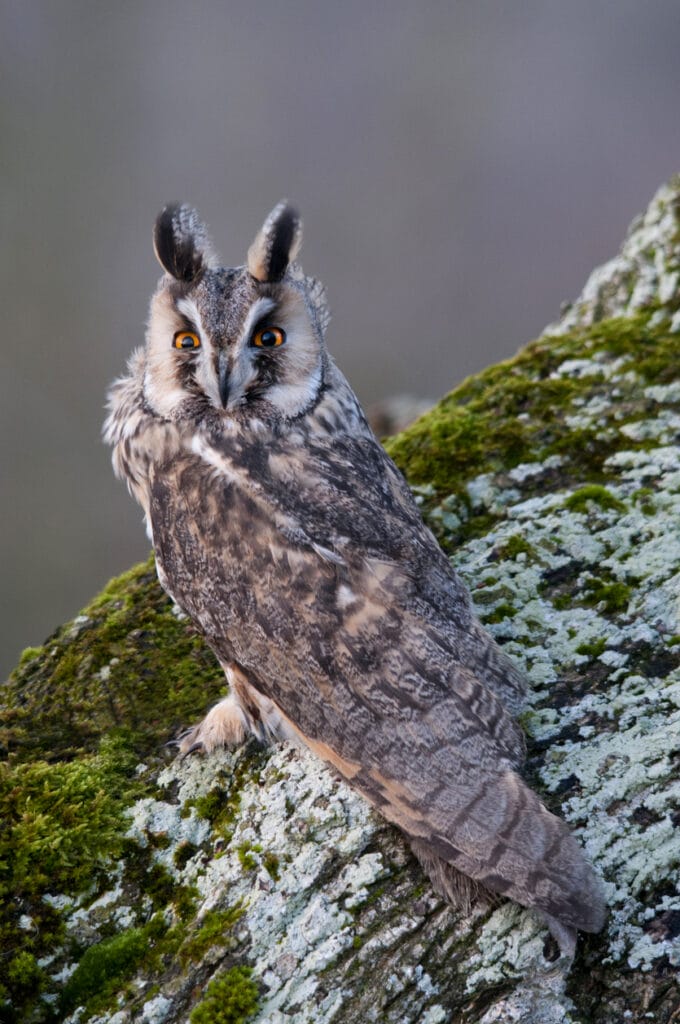
- Scientific name: Asio otus
- Length: 13.5 to 15.7 inches
- Wingspan: 35 to 40 inches
- Weight: 8 to 9 ounces
- Lifespan: 10 to 11 years (wild); 27 years (oldest recorded)
As the name suggests, Long-eared Owls have long, protruding ear tufts. They’re often misrepresented for Great Horned Owls because they both have tufts, except the former are much shorter than the latter. Because of this, they’re given the name, “Lesser Horned Owls.”
Aside from the tufts, Long-eared Owls are unique in their own right. They have dark, patterned plumages, pumpkin-colored facial discs, and large, yellow eyes.
Long-eared Owls are uncommon in Virginia and can only be spotted in the northern part of the state during winter. They live in densely vegetated open areas like shrublands and grasslands, as well as orchards, farmlands, gardens, and parks.
They roost on top of tall trees, perfectly camouflaged in their barks.
Although rare in Virginia, they’re easier to find than Snow Owls. They’re considered one of the most vocal species of owls, producing over 200 sounds including squeals, hoots, whines, screeches, meows, and barks.
The vocalizations of male Long-Eared Owls are so loud they can be heard almost a mile away.
5. Short-eared Owl
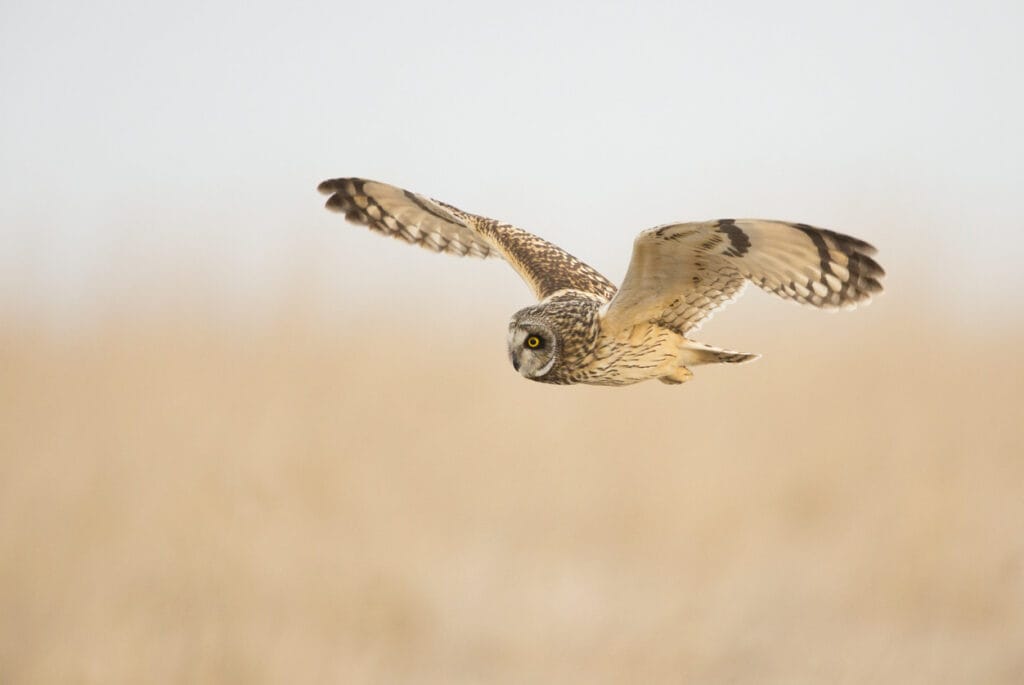
- Scientific Name: Asio flammeus
- Length: 12 to 18 inches
- Wingspan: 33.5 to 40.5 inches
- Weight: 7.3 to 16.8 ounces
- Wingspan: 33.5 to 40.5 inches
- Lifespan: 4 to 5 years (wild); 12 years (oldest recorded)
Although rare, Short-eared Owls have a remarkably extensive range; they can be seen in all regions of Virginia! They typically stay near open areas such as grasslands and farmlands, perked atop low tree limbs.
Short-eared Owls are one of the few species that build their nests on the ground. Female Short-eared Owls make a scrape on the ground and line it with herb stalks, grass stems, and feathers. If she can’t find animal feathers, she’d pluck several from her breast. They breed from March through June.
Author Note: Like Barred Owls, Short-eared Owls are diurnal. They often hunt in broad daylight, chasing after prey close to the ground and pouncing from above.
Short-eared Owls are described to have “flame-colored” plumage, hence the Latin scientific name Asio flammeus. Their ear tufts usually lay flat on their round heads, but they’d point them upwards when they want to intimidate an animal.
These owls rarely call out, but when they do, they sound like small cats or dogs calling for a mate.
Short-eared Owls are opportunistic feeders. They mostly eat small mammals and rodents, such as lemmings, voles, pocket mice, rabbits, gophers, and the like. They also eat small birds and insects.
6. Barn Owl

- Scientific name: Tyto alba
- Length: 12.5 to 15.9 inches
- Wingspan: 39.5 to 49.5 inches
- Weight: 14 to 24.7 ounces
- Lifespan: 2 to 4 years (wild); 15 years (oldest recorded)
Barn Owls are one of Virginia’s loyal year-round residents.
They’re best known for their “ghostly” appearance with their unique heart-shaped face, mottled tawny-gray feathers, big black eyes, and eerie calls.
Some people find their peculiar appearance beautiful, but others find them unsightly or terrifying; so much so that they’re given monikers like Monkey Owls, Demon Owls, Ghost Owls, and sometimes even Death Owls.
I’m among those who find them astonishingly beautiful. They may not appear as “grand” as Great Horned Owls, but they’re sophisticated and elegant, even when they’re on a hunt.
Although Barn Owls nest throughout the year in Virginia, they only ever breed in February through June. When winter comes, they roost in junipers and warm straw bales to conserve energy and protect themselves from wind and cold. You’ll also find them nesting in church steeples, chimneys, barn lofts, and cliffs.
Barn Owls don’t build nests, so they search for a level or concave surface to lay eggs. They generally feast on cotton rats, house rats, and young rabbits, totaling up to 95% of their diet.
While fairly large in size, these creatures are relatively docile. They rarely attack humans, and when they do, it’s only if they feel threatened or attacked themselves. When a predator of a bigger size approaches them, they’d usually fly off instead of causing trouble. So, if you spot a Barn Owl in the distance, best admire it from afar.
Barn Owls mostly hunt at night, swooping in search of prey.
7. Northern Saw-whet
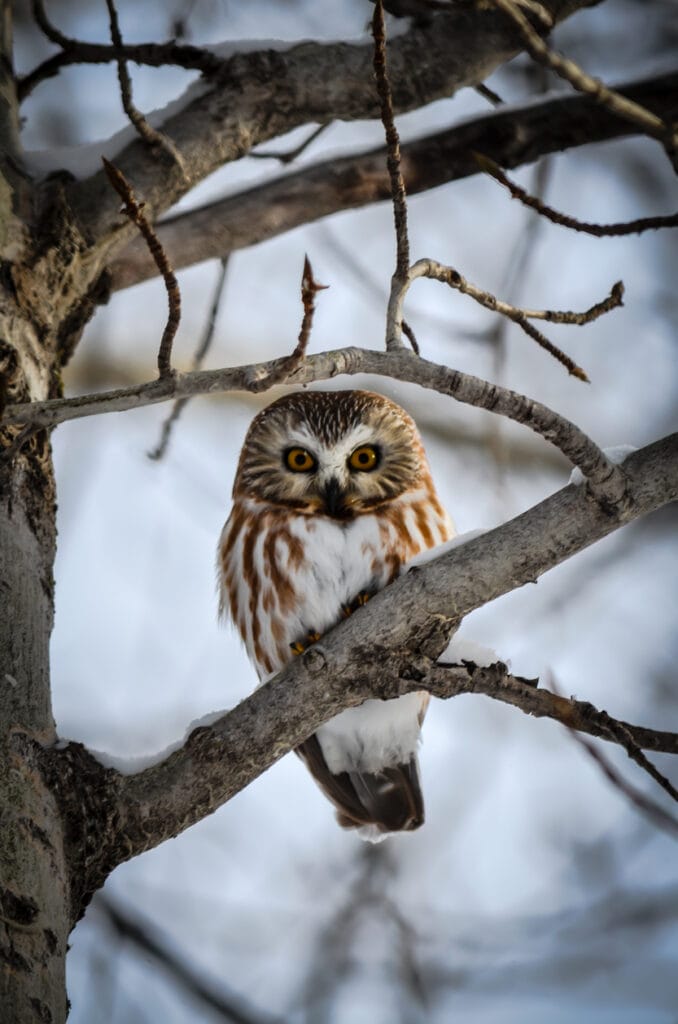
- Scientific name: Aegolius acadicus
- Length: 6.5 to 8.5 inches
- Wingspan: 16.5 to 22 inches
- Weight: 1.9 to 5.3 ounces
- Lifespan: 7 years (wild); 9 years (oldest recorded)
Northern Saw-whet Owls are one of the smallest species of owls in Virginia. They’re less than 10 inches tall, with adorably oversized heads, fluffy bodies, and huge, cat-like yellow eyes. To top it all off, they have heart-shaped faces that add to their overall appeal.
If this were a list of cutest owls alive, the Northern Saw-whet surely tops the list. But although cute, their warning calls are nothing but.
When startled, their screeches resemble the whetting of a saw, hence the name. They can still keep the “adorable” title, though, because they only ever make these sounds during mating season or when they’re threatened.
Author Note: In Virginia, you’ll only ever find non-breeding populations of Northern Saw-whet Owls. Their extra small size and camouflage coloring make them difficult to spot. Even conservationists who study owl behavior have a hard time finding them.
If you want to try your luck, search for them in oak woodlands, coniferous forests, or streamside woodlands—these are the areas they most frequent.
Like most owls, Northern Saw-whet Owls eat just about anything. But since they’re so small, they’re limited to small rodents like mice, voles, young squirrels, insects, and tiny birds.
8. Barred Owl
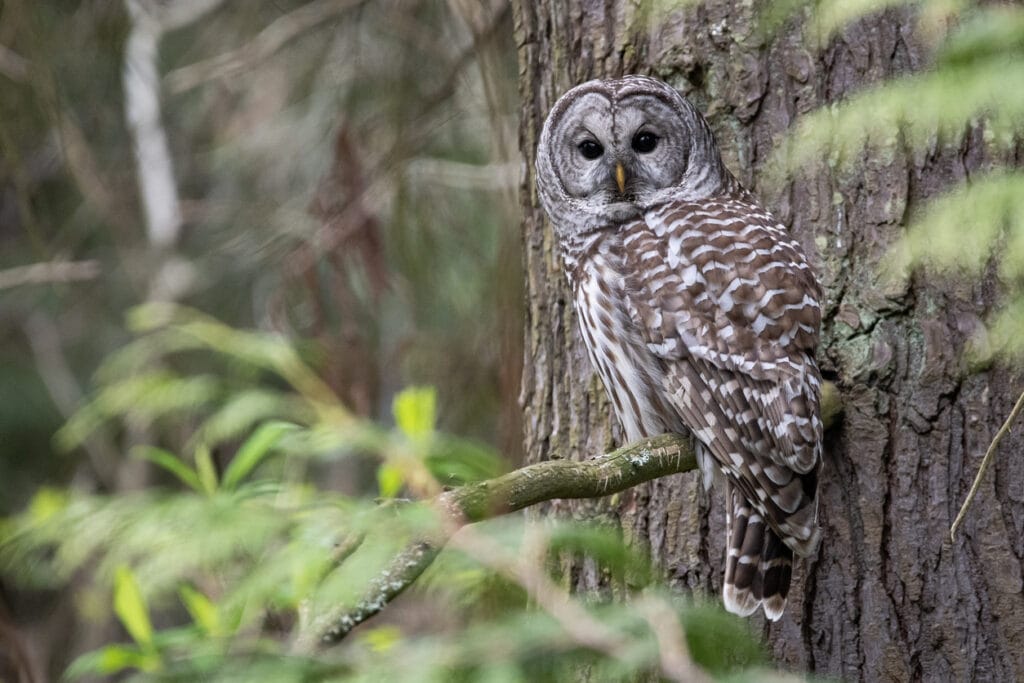
- Scientific name: Strix varia
- Length: 15 to 25 inches
- Weight: 26 to 30 ounces
- Wingspan: 35 to 50 inches
- Lifespan: 8 years (wild); 24 years (oldest recorded)
Found in evergreen forests, swaps, uplands, and everything in between, Barred Owls are widely recognized for their unique “who cooks for you?” call and white-and-brown plumage.
Top Tip: Unlike most owls, Barred Owls are diurnal, meaning they hunt day and night. For this reason, they’re the most easily-spotted owls in Virginia.
Barred Owls have large, round eyes, fluffy, heart-shaped faces, “barred” feather patterns, short tails, and stocky bodies. Since they don’t travel or migrate far from their homes, chances are you’ll find the exact same bird in the exact same location when you return to Virginia months later.
These owls typically feast on small mammals like mice, rats, and squirrels, but they won’t say no to snakes and other invertebrates. They’ll also hunt fish from lakes and swamps if it strikes their fancy.
Although considered as one of the friendliest owls in the world, Barred Owls are extremely territorial, especially during nesting season. They chase away intruders while hooting loudly, and would sometimes strike said intruders with their claws to leave.
Final Thoughts
Virginia is brimming with wildlife and unique birds. Currently, there are a total of 8 owls in Virginia. Some can be seen in almost every region of the state, while others—like Snowy Owls and Long-eared Owls—visit under specific circumstances.
The listed owls are unique in their own ways, so if you’re planning to snap a few pics of these gorgeous owls, learn more of their natural behaviors.
Upon spotting one of these owls, watch them from afar for both you and the animal’s safety.
FAQ
Audubon recommends these places for seeing several species of owl: Eastern Shore of Virginia National Wildlife Refuge, Great Dismal Swamp National Wildlife Refuge.
Great Horned and Barn Owls are probably the most common in Virginia.
To find out where recent sightings of owls have been, try eBird. You can search for the latest sightings or particular species or what has been seen in a certain area.




